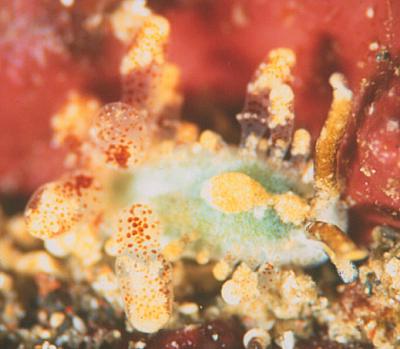
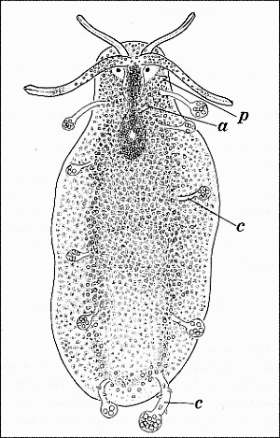
Sohgenia palauensis
Hamatani, 1991
Order: SACOGLOSSA
Superfamily: LIMAPONTIOIDEA
Family: Caliphyllidae
DISTRIBUTION
Probably widespread in tropical Indo-west Pacific. Originally reported from Palau, there are now records on the Forum from the tropical NW Pacific and southwestern India.
PHOTO
UPPER: Hachijo Island, Japan. Depth 5m, length 8mm, photographed only once at a shallow reef. Photo: Shoichi Kato.
LOWER: From Hamatani, 1991 - Figure 1.
Until reported on the Forum this species was known only from the original description which is summarised below:
"Body leaf-shaped and very thin 4.5mm long. Foot undivided and occupies the whole ventral surface of the body. General body colour is grass green due to presence of green pigments possibly derived from the animal's food. The rhinophores are very close together and bifurcate very close to the base. The upper half of the rear branch (of the rhinophores) is tinged slightly with brown. The cerata are stick-shaped with a spherical swelling at the top, wholly transparent and colourless. The stalk can have some minute conical protuberances. No gut branches penetrate into the cerata"
In the original description the cerata are quite a bit smaller and there are no brown spots, but the pericardial hump has two swellings like in these photos, and the general shape is very similar. It has similarities to a species of Cyerce or Polybranchia which have autotomised most of their cerata, but the swollen tip of the cerata, and the brown pigmentation on the rhinophores is quite unusual for those genera.
Reference:
• Hamatani,I (1991) Sohgenia palauensis n. gen. & sp., a new ascoglossan opisthobranch from the Palau Islands collected by the R/V Sohgen-Maru. The Venus, The Japanese Journal of Malacology, 50(2): 85-92.
Rudman, W.B., 2002 (February 1) Sohgenia palauensis Hamatani, 1991. [In] Sea Slug Forum. Australian Museum, Sydney. Available from http://www.seaslugforum.net/find/sohgpala
Related messages
Sohgenia palauensis? from southwestern India
December 21, 2009
From: Apte Deepak
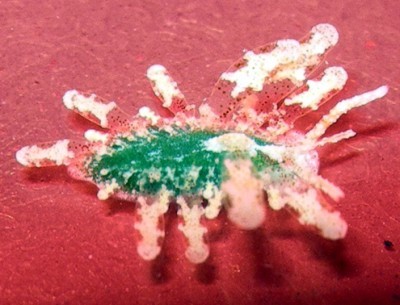
Concerning message #6142:
Dear Bill
Is it by any chance Sohgenia palauensis?
Locality: Lakshadweep, 2m, India, Lakshadweep Sea, SW coast of India, 16 December 2009, Reef. Length: 8 mm. Photographer: Deepak Apte.
Deepak Apte
spiderconch@gmail.com
Apte, D.A., 2009 (Dec 21) Sohgenia palauensis? from southwestern India. [Message in] Sea Slug Forum. Australian Museum, Sydney. Available from http://www.seaslugforum.net/find/23008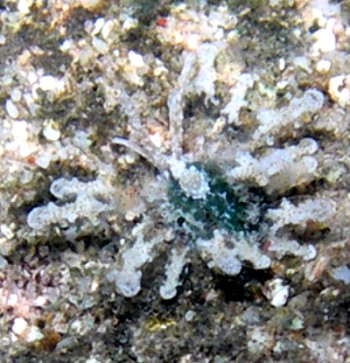
Dear Deepak,
I have no doubt that your animal is the rarely reported Sohgenia palauensis. It fots the original description and other photos we have of it on the Forum very well. Your find is another huge range extension. This species was previously known only from the tropical NW Pacific.
Best wishes,
Bill Rudman
Sohgenia. palauensis from Palau
March 22, 2002
From: Clay Carlson

Bill,
Here is a shot of S. palauensis on some substrate -- can be a bit hard to make out in the field.
Data: 8.5mm Palau, Mariculture Center, reef flat. 25 June 1977. Host: ??
Our original notes say undivided foot. I just checked a couple of bottled animals -- no sign of any division.
Cheers,
Clay & Patty Jo
ccarlson@saba.kuentos.guam.net
Carlson, C., 2002 (Mar 22) Sohgenia. palauensis from Palau. [Message in] Sea Slug Forum. Australian Museum, Sydney. Available from http://www.seaslugforum.net/find/6513Dear Clay & Patty Jo,
Thanks for this information. This animal is starting to look much more appealing than the unfortunate cerata-less animal described by Hamatani.
Best wishes,
Bill Rudman
Re: Transverse groove in foot of Sohgenia
March 22, 2002
From: Kathe R. Jensen
Dear Atsushi,
Thank you so much for these 2 excellent photos of Cyerce and Sohgenia. There is one additionally feature, which shows clearly on these pictures, and which I cannot remember whether Hamatani commented on in his description of Sohgenia. The digestive gland in Cyerce is a solid mass, as in the shelled sacoglossans, whereas you can easily distinguish a network of fine tubules through the skin of the foot in Sohgenia.
Thanks again - this really adds to the number of characters separating the genus Sohgenia.
Kathe
jensen@ait.ac.th
Jensen, K.R., 2002 (Mar 22) Re: Transverse groove in foot of Sohgenia. [Message in] Sea Slug Forum. Australian Museum, Sydney. Available from http://www.seaslugforum.net/find/6516Transverse groove in foot of Sohgenia
March 21, 2002
From: Atsushi Ono
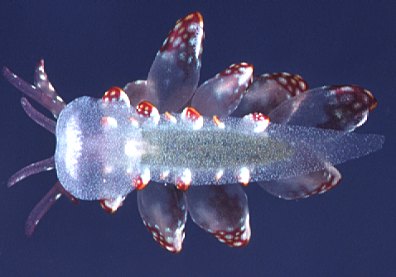
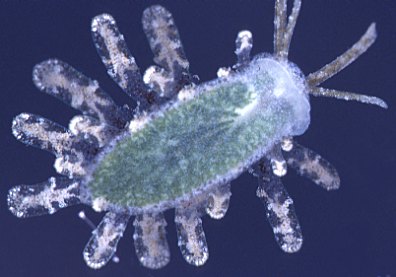
Dear Bill and Kathe,
Following our earlier conversation I fortunately found at third specimen of Sohgenia palauensis [LOWER PHOTO] and Cyerce kikutarobabai [UPPER PHOTO].
I live in an isolated island, it took long to develop films. I don't know "transverse groove" so I tried to take photos of foot.
Can you see it in my photo of C. kikutarobabai?
Sincerely,
Atsushi Ono
ononini@cosmos.ne.jp
Ono, A., 2002 (Mar 21) Transverse groove in foot of Sohgenia. [Message in] Sea Slug Forum. Australian Museum, Sydney. Available from http://www.seaslugforum.net/find/6474Dear Atsushi,
Thanks very much for these two photos which show the difference very well. In the upper photo we can see a roundish anterior disc and then an elongate tapering section of the foot. The 'groove' separating the two parts of the foot is in line with the front pair of the large dorsal cerata. In the lower photo, of Sohgenia there is no sign of the groove. Another feature which can be clearly compared is the presence of oral tentacles in Cyerce and their absence in Sohgenia. Although it looks like their are two pairs of head tentacles in Sohgenia, what we can see is one pair of rhinophores which bifurcate into two arms right near the base.
Best wishes,
Bill Rudman
Sohgenia palauensis
March 14, 2002
From: Atsushi Ono
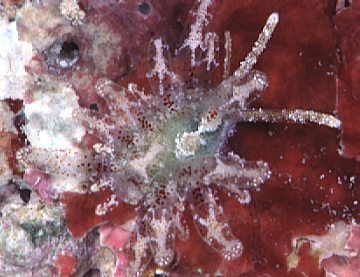
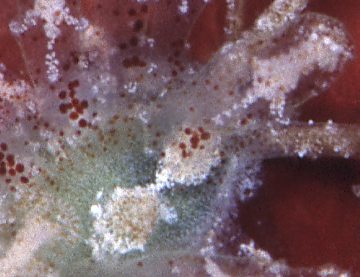
Dear Bill,
I found a photo of the dorsal view of "Sohgenia" species. I can see the white object and anal papillae you mentioned in your message. It is very similar to Hamatani's monochrome photo.
Sincerely,
Atsushi Ono
ononini@cosmos.ne.jp
Ono, A., 2002 (Mar 14) Sohgenia palauensis. [Message in] Sea Slug Forum. Australian Museum, Sydney. Available from http://www.seaslugforum.net/find/6415Thanks Atsushi,
I have a message from Clay Carlson, which I'll post tomorrow, reporting that this animal doesn't have a tranverse groove on the foot, so I think we can be pretty confident that this is indeed Sohgenia palauensis.
Cheers,
Bill Rudman
Re: Sohgenia? from Kerama Ids
March 6, 2002
From: Kathe R. Jensen
Dear Bill and Atsushi,
I am very excited to see these pictures of Sohgenia. According to Hamatani's description this genus does not have oral tentacles, and I don't see any oral tentacles on Atsushi's picture. Also, Sohgenia apparently does not have a transverse groove in the foot sole. This, unfortunately cannot be seen in either of the two pictures on the Forum. The genus Cyerce has oral tentacles and a transverse groove in the foot sole. If Atsushi has a preserved specimen, it would be easy to check if the transverse groove is found on the foot sole.
Greetings,
Kathe
jensen@ait.ac.th
Jensen, K.R., 2002 (Mar 6) Re: Sohgenia? from Kerama Ids. [Message in] Sea Slug Forum. Australian Museum, Sydney. Available from http://www.seaslugforum.net/find/6344Dear Kathe,
It is indeed an interesting find. Atsushi, if you have the specimen, the transverse groove on the sole, if present, will be at the anterior end, at about the level of the anterior cerata.
Best wishes,
Bill Rudman
Sohgenia? from Kerama Ids
February 24, 2002
From: Atsushi Ono
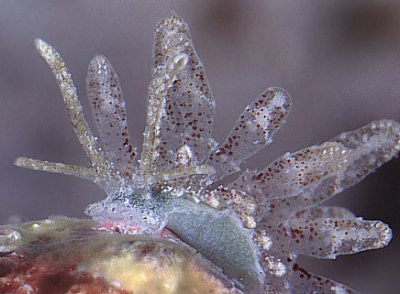
Dear Bill,
The animal in the attached photo is very similar to Kato's animal. This is the animal I identified as as Eubranchus sp. 2 in my book but now I think it sacoglossa species. I had thought it was Mourgona sp....
Photo: May 28 2001, Zamami Is. 6m depth in Kerama Ids. 6mm long.
(I collected a specimen of this individual. All the big cerata came off which made it look very similar to Hamatani's painting.)
This is the second individual I have seen.
Sincerely,
Atsushi Ono
ononini@cosmos.ne.jp
Ono, A., 2002 (Feb 24) Sohgenia? from Kerama Ids. [Message in] Sea Slug Forum. Australian Museum, Sydney. Available from http://www.seaslugforum.net/find/6231Dear Atsushi,
Thanks for this excellent photo. It makes me even more convinced that Hamatani's animal had lost most of its cerata when it was collected, or at least seen by him. Only two genera of the caliphyllids, Cyerce and Sohgenia, have the anus opening on a papillae midway between the eyes and the pericardium. If you look at Hamatani's drawing you can see it labelled '(a)'. If you look at Kato's photo there is a white object in the same position which I assume is the anal papilla. If so this would make his animal either Sohgenia or a Cyerce which has lost most of its cerata. The shape of the cerata, like in your photo, are cylindrical, quite unlike the flattened cerata of Cyerce. On these grounds I think we can be pretty sure that Sohgenia is not naturally 'bald' as in the original description, but has a full set of cerata, in normal circumstances. Of course its anatomy would need to be checked before we could be 100% sure.
Best wishes,
Bill Rudman
Sohgenia palauensis? from Japan
February 3, 2002
From: Shoichi Kato

Dear Dr. Bill Rudman
I run a diving shop on Hachijo Island in Japan. Hachijo lies in the Pacific Ocean about 300km south of Tokyo. The climate is temperate but a lot of sea creatures which usually live in tropical or subtropical regions inhabit the area because of the Japan Current. Since this area is close to the Ogasawara Islands, many living things of the Ogasawara series are also seen. Thus, Hachijo is a treasure house of diverse living things.
When researching sea slugs, I come across many kinds of sea slugs which are not in the illustrated reference books, and I find it difficult to identify them. I understand that you are an expert in this area, so I'm hoping you could help me.
Here is a photo of one of the animals I can't identify. Mr Ono of Kerama islands said it is a sacoglossan.
Depth 5m, length 8mm, photographed only once at a shallow reef.
Sincerely,
Shoichi Kato
regulus@edit.ne.jp
Kato, S., 2002 (Feb 3) Sohgenia palauensis? from Japan. [Message in] Sea Slug Forum. Australian Museum, Sydney. Available from http://www.seaslugforum.net/find/6142Dear Shoichi,
This is an interesting animal. I think it is probably Sohgenia palauensis a species which has only been reported from the Palau Ids. It is closely related to the species of Cyerce and Polybranchia. I can't be totally certain of the identification because the only description I have seen of it is the original one by Dr Hamatani. His specimen did not have brown spots as in your specimen and the cerata were never as large as in your animal but it is possible that the colour is a bit variable in this species and it is also possible that some of the larger cerata in Hamatani's animal had dropped off before he had a chance to examine the animal.
Have a look at Hamatani's drawing and his description which I have included in the Fact Sheet for this species.
Best wishes,
Bill Rudman
